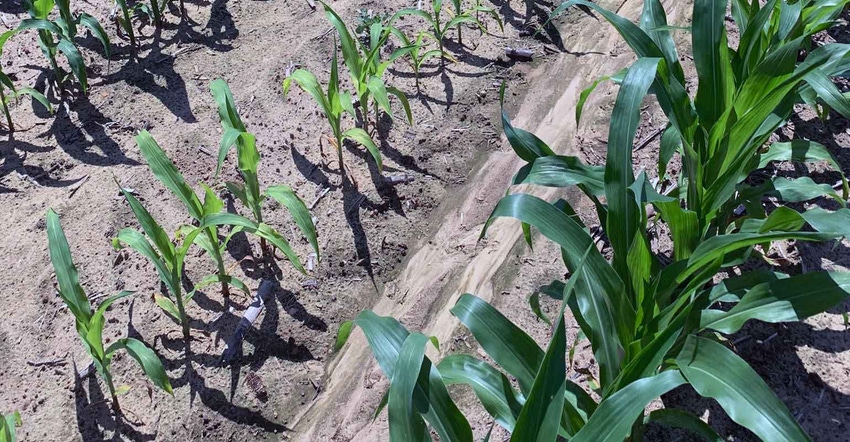
Borrowing a line from NACAR racing, if the 2022 cropping season ended now, it might be remembered as “the year of stunted corn.” I suspect that nematodes have played a significant role in the presence of stunted corn for three reasons.
First, the warmer “La Niña Winter” allowed volunteer corn and other hosts for nematodes to survive long into the winter, allowing populations to continue to build. Second, because of prices, more corn is being planted behind corn this year; short rotation (or no rotation) makes nematode problems more severe. Third, warm soils in late winter and early spring have resulted in nematodes that are active (and hungry) long before the corn seed was planted.
Still early in the season, I have spent hours with county agents, consultants, and growers walking corn fields and assessing where growth, sometimes large areas, is poor and plants are stunted. Where similar symptoms occur in cotton or peanut fields, I can more easily diagnose nematode problems.

In corn, nematode damage on roots can be more subtle. Credit: Bob Kemeriat, UGA Extension.
For peanut and often cotton, the obvious presence of galling on the roots allows for quick and accurate diagnosis. Where galls are not present, soil tests usually tell me whether or not nematodes are the problem.
In the corn crop, nematode damage on roots is also diagnostic, but can be more subtle. Subtle damage to the roots from nematodes coupled with potential for other factors, to include soil fertility issues, makes accurate diagnosis of stunted corn more challenging.
Suspecting nematode damage in a field planted to corn in 2021 and now again in 2022, a county agent in southwestern Georgia recently submitted a soil sample for nematode analysis. The sample was collected in a field where stunting and visible root damage were consistent with nematodes. No nematicide had been applied to this field. The sample comes back with “15 stubby root nematodes/100cc soil,” which is further indication as to the basis for the problem.
At the University of Georgia, economic thresholds are used as indicators of when a population of nematodes in a field is high enough to justify the expense of a nematicide. Economic thresholds at UGA are based on samples collected at harvest; we do not have economic thresholds for samples taken in the spring or soon after planting.
Though nematodes cause severe damage to a crop early in the season, interpretation of early-season results is challenging. Where “15 stubby-root nematodes/100 cc soil” may not seem problematic in a post-harvest sample, this population early in the season when the young root system is developing could lead to significant damage.
Included here is an UAV image provided by Jeremy Kichler, UGA Extension Agent in Colquitt County. This image demonstrates the power of such imagery to provide better understanding of patterns of symptoms in a field. Even with only a quick glance, it is obvious that something is causing severe damage in the field. Our task is to determine what that “something” is.

Credit: Jeremy Kichler, UGA Extension
Stunting in fields is caused by different problems. In my world, damage is often the from plant parasitic nematodes. In Dr. Glen Harris's world of soils and soil fertility, stunting can be associated with inadequate fertilizer, soil pH problems, and with salt injury. For our weed-scientist Dr. Eric Prostko, early season damage could be associated with an herbicide issue.
In some situations, the cause of poor growth may result from a complicated combination of factors. Most importantly, UAV images help us to better identity the cause of the problem and to focus on further sampling soil sampling efforts.
Though the UAV image is informative, accurate interpretation requires care. From this image alone it is just as likely that this damage is the result of fluctuations in soil pH across the field as it is nematodes. To most accurately diagnose a problem of stunted corn requires that samples be collected to assess soil fertility, soil pH, and nematodes.
To best understand if nematodes are associated with the stunting, at least two soil samples should be submitted. The first sample should be combined from cores collected in the areas of the field where stunting is observed. The second sample should be from combined cores from the “good” areas of the field where stunting is not observed. Samples for nematode testing should be kept cool after collection and should only be collected when there is adequate soil moisture in the field. Soil cores MUST be collected within the root zone of the plants to a depth of about 6 to 8 inches.
Unfortunately for corn growers, if the stunted corn is the result of nematodes, then the race really did end now for further control. The best and most effective tactics for management of nematodes affecting corn, cotton, peanuts, and soybeans are applied before the furrow is closed. However, understanding a problem now allows for best management for next year.
About the Author(s)
You May Also Like






